This's additionally a great option if you are looking for a very western as well as rustic feel for your bathroom. Moen is a respected brand that is recognized for delivering high quality, long lasting products. No doubt, bathroom faucets and bathroom fixtures could be the finishing point for the bathroom of yours and can be what makes or even breaks the overall look of your bathroom.
Images about Modern Wall Mounted Bathroom Faucets

A number of faucets look fantastic in the beginning then again quickly start leaking due to the plastic parts on the interior. This design typically features one main faucet head and 2 individual handles; one for every climate control. The quality of Moen items is really great, the company warrants the faucets of its to be leak and drip-free for a lifetime.
BULUXE Wall Mounted Waterfall Bathroom Sink Faucet, 2-Hole Single
The succeeding point to be analyzed in bathroom faucets is the caliber of the finish. There are actually three specific benefits of using these over the other kinds. If you're unsure as to what kind of vanity your bathroom would match best with, well you should give some thought to looking for modern day vanity. Though it's expensive, it's incredibly durable and offers enduring performance.
T3567LF-BLWL Delta Ara Wall Mounted Bathroom Faucet u0026 Reviews
Typically you will have to place the spout on the wall plate, accompanied by the washers before fastening it with a screw. A brand new countertop installation may be needed, since minimal of the sink surface touches the kitchen counter and have a vessel sink, leading to a spectacular visual statement. Popular makes come from Delta and Kohler.
Modern Wall Mounted Faucet Wayfair
Wall Mounted Bathroom Faucets
15 Modern Wall-Mounted Faucet Design Ideas to Complete Your
M.E. Wall-Mounted Lavatory Faucet :: Bathroom :: GRAFF
Buy Delaware Contemporary Double Handle Wall Mounted Bathroom Sink
Juno Chrome Finish LED Wall Mounted Bathroom Sink Faucet
15 Modern Wall-Mounted Faucet Design Ideas to Complete Your
Edenton Wall-Mount Bathroom Faucet
Modern Wall Mount Bathroom Sink Faucet with Single Handle Solid
Single Handle Wall Mount Bathroom Faucet Trim
Wall Mounted Bathroom Faucet 2 Handle Modern Bathroom Sink Faucets
Related Posts:
- Pull Down Bathroom Faucet
- Cost To Change Bathroom Faucet
- Delta Touchless Bathroom Faucet
- Danco Bathroom Faucet Parts
- Concinnity Bathroom Faucets
- Removing Bathroom Faucet Nuts
- Replace Cartridge Bathroom Faucet
- Traditional Bathroom Faucets
- Old Style Bathroom Faucets
- Tuscan Bathroom Faucets












